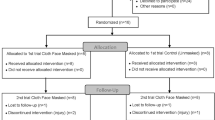Summary
The isometric endurance of forearm muscles at 40% maximum voluntary contraction was measured in six healthy male subjects, after they had walked for 25–30 min on a treadmill while wearing an impermeable gas protective suit and a self-contained breathing apparatus at a light (21%\(\dot V_{{\text{O}}_{\text{2}} {\text{ max}}}\)), and a moderate 41%\(\dot V_{{\text{O}}_{\text{2}} {\text{ max}}}\)) work level. The mean endurance times were 12% (NS) and 24% (P<0.01) shorter than the average control value after exercise for the light and moderate work levels, respectively. These changes were accompanied by an increased heart rate, and rectal and skin temperatures. Ventilating the suit with an air flow of 281·min−1 at the moderate work level did not significantly affect isometric endurance (decreased 27%), heart rate or body temperatures. It was concluded, that muscular performance capacity is reduced after wearing gas-protective clothing in a temperate environment, presumably due to the increased muscle temperature, and this should be considered in scheduling work times and rest periods.
Similar content being viewed by others
References
Brown JR (1965) Impermeable clothing and heat stress. Med Serv J Can 21: 518–532
Clarke RSJ, Hellon RF, Lind AR (1958) The duration of sustained contractions of the human forearm at different muscle temperatures. J Physiol 143: 454–473
Edwards RHT, Harris RC, Hultman E, Kaijser L, Koh D, Nordesjö L-O (1972) Effect of temperature on muscle energy metabolism and endurance during successive isometric contractions, sustained to fatigue, of the quadriceps in man. J Physiol [Lond] 220: 335–352
Hall VE, Munoz AM, Fitch B (1947) Reduction of the strength of muscle contraction by application of moist heat to the overlying skin. Arch Phys Med Rehab 28: 493–499
Humphreys PW, Lind AR (1963) The blood flow through active and inactive muscles of the forearm during sustained hand grip contractions. J Physiol [Lond] 166: 120–135
Louhevaara V, Tuomi T, Korhonen O, Jaakkola J (1984) Cardiorespiratory effects of respiratory protective devices during exercise in well-trained men. Eur J Appl Physiol 52: 340–345
Mitchell D, Wyndham CH (1969) Comparison of weighting formulas for calculating mean skin temperature. J Appl Physiol 26: 616–622
Nukada A (1955) Hauttemperatur und LeistungsfÄhigkeit in ExtremitÄten bei statischer Haltearbeit. Int Z Angew Physiol einschl Arbeitsphysiol 16: 74–80
Petrofsky JS, Burse RL, Lind AR (1981) The effect of deep muscle temperature on the cardiovascular responses of man to static effort. Eur J Appl Physiol 47: 7–16
Shvartz E, Benor D (1972) Heat strain in hot and humid environments. Aerospace Med 43: 852–855
Tanaka M, Brisson GR, Volle MA (1978) Body temperatures in relation to heart rate for workers wearing impermeable clothing in a hot environment. Am Ind Hyg J 39: 885–890
Wasserman K, Whipp BJ, Koyal SN, Beaver WL (1973) Anaerobic threshold and respiratory gas exchange during exercise. J Appl Physiol 35: 236–243
Yates JW, Gladden LB, Cresanta MK (1983) Effects of prior dynamic leg exercise on static effort of the elbow flexors. J Appl Physiol: Respirat Environ Exercise Physiol 55: 891–896
Author information
Authors and Affiliations
Rights and permissions
About this article
Cite this article
Smolander, J., Louhevaara, V., Tuomi, T. et al. Reduction of isometric muscle endurance after wearing impermeable gas protective clothing. Europ. J. Appl. Physiol. 53, 76–80 (1984). https://doi.org/10.1007/BF00964694
Accepted:
Issue Date:
DOI: https://doi.org/10.1007/BF00964694




